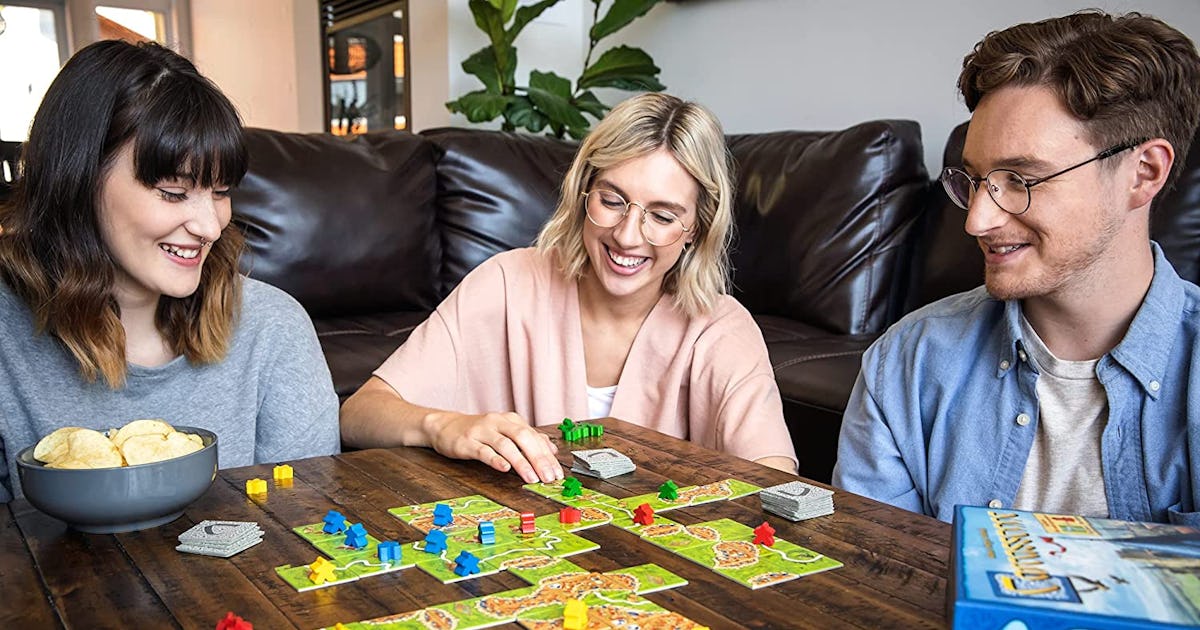
If you’re not much of a game player (yet!), the best board games for beginners have easy-to-learn rules and simple game mechanics to ease you into things — but they’re still challenging enough to be fun for repeat play. The rules are the framework of the game (what the goal is, how to win, and what players can do), while game mechanics are the actual elements of gameplay (like rolling dice, drawing cards, or navigating the board). Board games for beginners shouldn’t be too fussy or complicated in either of these areas, allowing players to get immersed without getting bogged down by the rulebook. That said, you want to pick a game that’s still entertaining even after everyone has the hang of it, so games with learn-as-you-go potential are great picks for new players. Look for options that are simple enough that you can start playing quickly but have additional variations or layers of strategy to keep things interesting. It’s helpful to look at reviews to see which games are fun and easy to learn — of course, every game on this list
There are many types of games to choose from, but strategy board games can be especially great for learning as you go. The objective for these games tends to be fairly straightforward because the core of gameplay is the player’s own strategic thinking. However, some strategy games have complicated rules or elaborate mechanics requiring a lot of setup time, so choose your game carefully. Party games, on the other hand, do a good job of keeping rules and gameplay simple for large groups, but take care to avoid ones that err on the side of too simplistic, since these may not be fun for too many repeat plays. Finally, cooperative board games can be a great way to dive into board games, since these are more story-driven and players work together to achieve a collective goal. Since talking through strategy and asking questions is built in to the gameplay, it can be an easy way for beginners to learn from experienced players.
This roundup includes a variety of board games that Amazon reviewers really enjoy, whether they’re seasoned board game pros or simply playing for the very first time.
1. An Editor-Approved Civilization-Building Game
- Players: 2 to 5
- Game time: 35 minutes
- Ages: 7+
In Carcassonne, the premise is simple: Players collect resources to build infrastructure and landscape features like roads, fields, monasteries, and cities (represented by tiles). When a player completes a feature and adds followers (the little brightly colored figures) to tiles, they earn points. Once all the tiles have been laid, players tally up their final scores — the one with the most points wins.
Strategy is key in this game, as you can choose to place your tiles in order to limit an opponent’s ability to reach their goals or allow you to share the points they earn. You also need a strategy to maximize scoring points with your followers. While the game is playable without any advanced plan in mind, you’ll quickly find yourself coming up with strategies and ideas to try out in the next match — making this game a great pick for its learn-as-you-go potential. Just ask one Bustle Commerce editor, who tried the game as a total beginner and found it super easy to pick up — and engaging enough that she wanted to play it again and again.
According to one reviewer: “The premise and style of this game is super unique and I would highly recommend it for anyone that’s looking for something new to play! […] For my personal style there is the perfect amount of strategy required — enough that I’m intellectually engaged, but not so much that it’s exhausting to play. I find that, personally, I often shy away from board games after a long work day because tedious strategy can be laborious. But I don’t have any qualms about picking up Carcassonne for a quick hour of play.”
2. A Word Game For Beginners With 4.8 Stars
- Players: 3 to 6
- Game time: 30 minutes
- Ages: 8+
With an overall 4.8-star rating after more than 3,500 Amazon reviews, Dixit is a popular choice for game nights with family and friends (experienced and beginner alike). And while the concept is simple, it’s complex enough that you’ll want to play long after you’ve mastered the basic rules. Players start with a hand of six cards, all with different beautifully drawn images on them. Each round, one player becomes the “storyteller.” When it’s your turn to play as the storyteller, you pick one of the cards from your hand and then describe it using clues which can be as simple as a word or two or as elaborate as a full story, song, or poem — it’s your choice! When you finish, you lay the card face down. The rest of the players choose a card from their hand that most closely matches the clues you gave and places those face down.
After shuffling the cards and facing them up, each player chooses the card they think belongs to the storyteller. Those who choose correctly get a point. Players also get points when others pick their card. Storytellers earn points when some (but not all!) players pick the right card. If all or no players pick it, they get zero points. If only some players pick it, they get a point for each player who does. Gameplay continues as players take turns as the storyteller until all the cards have been drawn — at which point the player with the most points wins the game.
While the rules are simple, mastering the strategy is a delicate balancing act, especially when it’s your turn to be the storyteller. You need to give clues that are clear enough that some players will be able to pick the right card but not so obvious that all players get it. This means you’ll catch on easily, but can enjoy the challenge of mastering the game with each group you play with.
According to one reviewer: “The game focuses on imagination and wits. It’s fairly easy to play and a quick moving game. Each player takes turns giving clues about their cards and you get points if you connect with your audience but not all of your audience (this is the part that I have had difficulty with). It can’t be too easy. Also when you are in the audience you have to try to figure out what the storyteller is trying to say with their clues.”
3. An Inexpensive Party Board Game For Beginners
- Players: 2+
- Game time: 15 to 20 minutes
- Ages: 10+
Zombie Dice is a popular party game with easy-to-learn rules and fast-paced gameplay. The “push your luck” style game comes with a set of 13 dice and a cup for rolling them. Each six-sided die has three images on it: brain, shotgun blast, and footsteps. Being a zombie, your goal is to eat as many brains as you can while avoiding getting shot.
During your turn, you can roll as many times as you like to try to get more brains, but you can only re-roll the dice that land on footsteps. If you roll three shotgun blasts, you’re dead and forfeit all your points. That’s where the challenge comes in. Each time you roll, you risk landing on another shotgun, but if you play too cautiously, you might not get enough brains to win.
The game is quick to learn, comes with just enough strategy to keep things interesting, and there’s no limit to how many people can play — which makes it an ideal pick for larger groups of players at all experience levels.
According to one reviewer: “Great game! Bought it randomly, because I wanted an easy game that I could play no matter how many people were over and that’s exactly what it is. Everyone who has played it loves it. For a simple game it still has enough complexity to make it fun. I would recommend it to anyone. Especially for the price.”
4. An Editor-Favorite Cooperative Board Game That’s Great For Beginners
- Players: 2 to 4
- Game time: 45 minutes
- Ages: 8+
Pandemic is a great example of a cooperative board game, where players are on the same team rather than competing against each other. Not only is a cooperative board game a great way for beginners to work together with more experienced players to learn the game, but Pandemic also has rules for three different tiers of difficulty, allowing you to start on an easier level and only try out the moderate or maximum difficulty rules when (and if!) you feel ready.
In the game, players are tasked with working together to stop the outbreak of four deadly diseases that are spreading simultaneously across the globe. To do that, each player takes on a different role, like medic, researcher, scientist, and so on. Each role comes with a set of special abilities. Throughout the game, players take turns drawing cards with cities or events. You use the cards to take actions, such as building a research station, discovering a cure, or treating the disease. Meanwhile, the infection will keep spreading each round. Occasionally, you’ll stumble on an Epidemic card which increases the rate of infection, spreading it to even more cities.
Players win the game when all four diseases have been eradicated. The strategy comes in figuring out how to prioritize actions as you work together to combat four different diseases spreading at different rates in different places — which may be easier or harder depending on the level of difficulty you choose for your game. According to a Bustle Commerce editor who has played this game a bunch of times, “While playing the game is pretty simple, actually winning the game can be harder — but either way, it’s a lot of fun, and you’re all in it together.”
According to one reviewer: “The game itself is fairly easy to get the hang of after a few turns and allows for great strategy sessions where you work together to eradicate the various diseases on the board to trigger the win condition. Playing at maximum difficulty will generally be pretty challenging and will require good planning and communication with the other players in order to succeed.”
5. A Version Of The Classic Strategy Game With Multiple Ways To Play
- Players: 2 to 5
- Game time: 2 to 3 hours
- Ages: 10+
With more than 6,500 (and growing!) Amazon reviews and a 4.8-star overall rating, Risk is a time-honored favorite among board game enthusiasts of all experience levels including beginners. Players start representing one of five possible empires, each with their own designated starting territory and armies on the board (which is a world map). The goal: conquer the globe by building up your army and taking over your opponent’s territory.
While the concept is simple enough to engage beginners, competition gets fierce as players take turns beefing up their armies and launching invasions. To win, players must outmaneuver their opponents while also making sure their own territory isn’t left vulnerable to invasion.
One of the unique perks of this edition of the classic game is the inclusion of alternative rules for different gameplay variations that will keep players engaged even when they’re no longer beginners. For those who are in the mood for a game of Risk, but not in the mood for a multi-hour strategy showdown, pick one of the alternative versions like Capital Risk for a faster-paced game.
According to one reviewer: “The game is great because you can play as a beginner or with an advanced strategy. You’ll develop plans of where to start your armies, what favorite territories you like, etc. The instructions are easy enough to follow for people without any experience playing Risk.”
6. A Strategy Board Game For Beginners With Simple Gameplay
- Players: 2 to 5
- Game time: 30 to 60 minutes
- Ages: 8+
In Ticket to Ride, each player is trying to build a railroad across the United States. While that might sound like a simple premise for a board game — and it is, in fact, simple enough for beginners — it’s also more challenging and fun than you might expect. So fun, the strategy game has earned an overall Amazon rating of 4.9 stars after more than 15,000 reviews.
While building your railroad, you’ll be competing with other players who are also trying to build their own railroads. Opponents can block each other’s paths and run railroads off the board, all in pursuit of the quest to earn the most points by laying down the most track. Stopping your opponents in their tracks (literally) can’t be your only strategy, though, as extra points are awarded for building especially long routes. The premise is easy to understand, but the strategy required to win ensures that this tile-laying game has endless replay value.
According to one reviewer: “[It’s] very simple to grasp. But there’s quite a bit of complexity, as most of the tasks can be completed multiple ways, and players can actively try to block one-another’s routes and strategies by getting to certain areas first. With dozens of locations on the map and numerous “tickets” to play, it makes each new playthrough fun and unique. There’s near-endless replay value, and with various expansions and “sequels” having been released, there’s even more potential for players who master this original edition.”
7. A Crime-Solving Cooperative Game With Immersive Storylines
- Players: 2 to 7
- Game time: 45 minutes
- Ages: 10+
Mysterium is a cooperative board game with an immersive storyline that makes it easy to dive in. Players must work together as a team of psychic investigators to analyze clues and solve a murder case — including figuring out who committed the crime, where they committed it, and what item they used to perform the grisly act.
During the game, one player chooses to be the ghost and the rest play as psychics. The ghost sits behind a screen that reveals the suspect, location, and weapon. While they know the truth about the crime, the ghost can’t speak. Instead, they knock on the table as the psychics talk through the case and attempt to solve it: one knock means yes, two means no. The ghost can knock to indicate when they’re headed in the right (or wrong) direction, and they can even occasionally give the psychics “visions” (cards) that hint at the suspect, location, or item.
The beautifully illustrated game is not only appealing for its storyline and aesthetics, but it’s also great for beginners because it’s such a cooperative experience and offers multiple difficulty levels. This allows you to start on an easier level and challenge yourself more as you become more comfortable with gameplay. It’s worth mentioning that multiple Amazon reviewers noted that the game requires a lot of setup, so consider if this might be a barrier to entry for you. But if you don’t mind a lot of pieces, get ready to reap the rewards of this game.
According to one reviewer: “Trying to communicate with abstract “visions” is surprisingly difficult; this game stays challenging after dozens of plays. It’s simple enough you can explain it to anyone fairly quickly, plus everyone working together makes it easier to bring a newcomer up to speed. It requires some real thought and discussion without being complicated. Overall, the most consistently fun board game I’ve played.”
8. A Strategy Game With Secret Identities
- Players: 2 to 6
- Game time: 30 to 45 minutes
- Ages: 8+
Spy Alley pits players against each other in a game of intrigue and deception. Each player draws a secret identity card, which tells you the country you are a spy for. The goal: figure out which country each of the other players is spying for, while also keeping your own identity secret. To do that, you use game money to pay for information, disguises, and other items that will help you either cover up your own identity or uncover someone else’s.
During your turn, you can guess another player’s identity instead of moving on the board. If you guess correctly, that player is eliminated from the game and you inherit all their cards, money, and items. If you guess incorrectly, you’re eliminated, and you forfeit all your cards, money, and items to the player you failed to identify.
The game ends when only one spy is left standing or when one spy makes it all the way across the board to their embassy without being identified. It’s an exciting, high-stakes competition with a premise that’s simple enough for beginners to grasp but still offers a lot of strategy.
According to one reviewer: “Spy Alley turned out to be the BIG HIT of our Christmas activities. Purchased with 8-yr-old grandchildren in mind, and it captivated not only the kids but parents and grandparents. Provides great variations for different levels of play from simple to more complex strategies. And game conversations can be delightful because of the roles and the intrigue.”
9. A Budget-Friendly Cooperative Board Game
- Players: 2 to 4
- Game time: 20 minutes
- Ages: 8+
The premise of The Mind is so simple that, at first glance, there doesn’t seem to be much to it. It’s a cooperative game where players work together to lay down cards in numerical order. The catch? You don’t know which cards any of the other players are holding and you can’t speak or use gestures to communicate with each other. Instead, players rely on body language and intuition to try to figure out which player has the next card in the sequence (which means the best players aren’t necessarily experienced game players so much as creative communicators). To win, players must play their cards in order from smallest to largest until there are no more cards in anyone’s hands. If a player puts down a card that’s higher than a card in someone else’s hand, everybody loses. As you level up, the sequence of cards gets higher, and it gets more and more challenging to play them in the right order.
According to one reviewer: “The premise is simple [as is] the description […] Basically, the less communication of any sort your group uses, the more magical the result will be. This game is VERY easy to pick up, but each game with a new group is unique, as part of the fun is watching how a group begins to “meld” their minds and succeed. It is best played with 4 players in my opinion, for a good balance of challenge and fun.”
10. A Visually Stunning Tile Placement Board Game For Beginners
- Players: 2 to 4
- Game time: 30 to 45 minutes
- Ages: 8+
With a 4.8-star overall rating after more than 7,000 Amazon reviews, Azul is popular for the engaging gameplay and the beautiful artwork. Players take turns claiming available tiles to either complete a pattern or build a collection. Points are earned for finishing particular kinds of patterns or completing a set of the same color tiles. Beginners have found it easy to set up and not too complicated to learn, making it a great way to start getting into games. But there’s more to it than just earning points, which keeps things interesting — you can use your turn to try to sabotage an opponent’s artwork, too.
According to one reviewer: “When you play, the first few rounds seem pretty simple. But as you get further in the game, the gameplay really tightens up and you have to think of the best way to move forward. Do you go for extra points? Or do you try to block your opponents from getting theirs? It’s both simple in design, and a little complex in strategy. Love that!”






